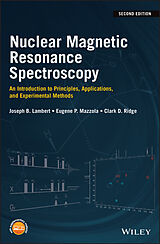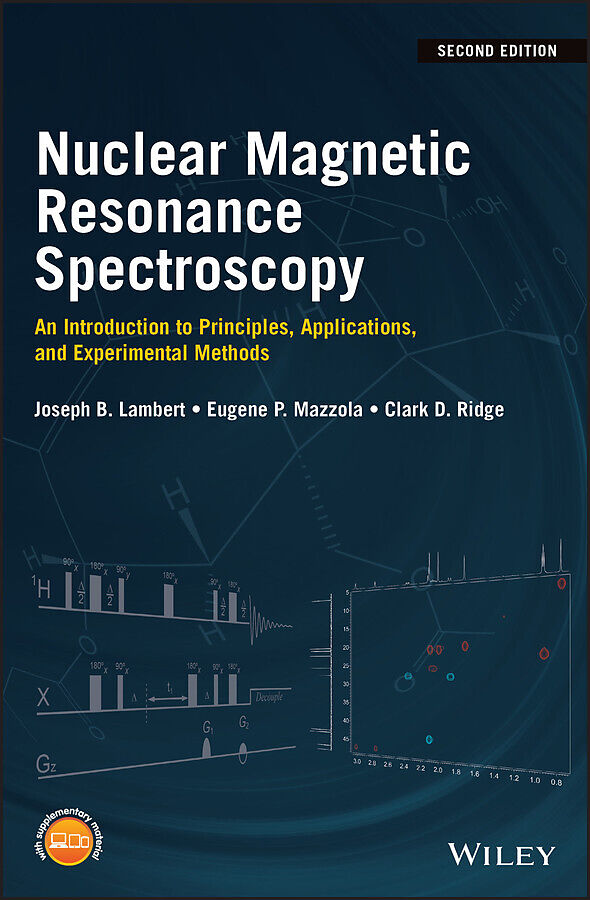Nuclear Magnetic Resonance Spectroscopy
Format:
E-Book (pdf)
EAN:
9781119295273
Untertitel:
An Introduction to Principles, Applications, and Experimental Methods
Genre:
Chemie
Autor:
Joseph B. Lambert, Eugene P. Mazzola, Clark D. Ridge
Herausgeber:
Wiley
Anzahl Seiten:
480
Erscheinungsdatum:
25.10.2018
Combines clear and concise discussions of key NMR concepts with succinct and illustrative examples
Designed to cover a full course in Nuclear Magnetic Resonance (NMR) Spectroscopy, this text offers complete coverage of classic (one-dimensional) NMR as well as up-to-date coverage of two-dimensional NMR and other modern methods. It contains practical advice, theory, illustrated applications, and classroom-tested problems; looks at such important ideas as relaxation, NOEs, phase cycling, and processing parameters; and provides brief, yet fully comprehensible, examples. It also uniquely lists all of the general parameters for many experiments including mixing times, number of scans, relaxation times, and more.
Nuclear Magnetic Resonance Spectroscopy: An Introduction to Principles, Applications, and Experimental Methods, 2nd Edition begins by introducing readers to NMR spectroscopy - an analytical technique used in modern chemistry, biochemistry, and biology that allows identification and characterization of organic, and some inorganic, compounds. It offers chapters covering: Experimental Methods; The Chemical Shift; The Coupling Constant; Further Topics in One-Dimensional NMR Spectroscopy; Two-Dimensional NMR Spectroscopy; Advanced Experimental Methods; and Structural Elucidation.
* Features classical analysis of chemical shifts and coupling constants for both protons and other nuclei, as well as modern multi-pulse and multi-dimensional methods
* Contains experimental procedures and practical advice relative to the execution of NMR experiments
* Includes a chapter-long, worked-out problem that illustrates the application of nearly all current methods
* Offers appendices containing the theoretical basis of NMR, including the most modern approach that uses product operators and coherence-level diagrams
By offering a balance between volumes aimed at NMR specialists and the structure-determination-only books that focus on synthetic organic chemists, Nuclear Magnetic Resonance Spectroscopy: An Introduction to Principles, Applications, and Experimental Methods, 2nd Edition is an excellent text for students and post-graduate students working in analytical and bio-sciences, as well as scientists who use NMR spectroscopy as a primary tool in their work.
Autorentext
Joseph B. Lambert, Ph.D., is Research Professor of Chemistry at Trinity University. Eugene P. Mazzola, Ph.D., is an adjunct professor of chemistry at the University of Maryland as well as a researcher at the UMDFDA Joint Institute for Food Safety and Applied Nutrition. Clark D. Ridge, Ph.D., is an NMR spectroscopist based at the Health and Human Sciences division of the FDA at College Park, Maryland.
Inhalt
Preface to First Edition Preface to Second Edition Symbols Abbreviations 1. Introduction 1.1. Magnetic Properties of Nuclei 1.2. The Chemical Shift 1.3. Excitation and Relaxation 1.4. Pulsed Experiments 1.5. The Coupling Constant 1.6. Quantitation and Complex Splitting 1.7. Commonly Studied Nuclides 1.8. Dynamic Effects 1.9. Spectra of Solids Problems Tips on Solving NMR Problems Bibliography 2. Introductory Experimental Methods 2.1. The Spectrometer 2.2. Sample Preparation 2.3. Optimizing the Signal 2.3a. Sample Tube Placement 2.3b. Probe Tuning 2.3c. Field/Frequency Locking 2.3d. Spectrometer Shimming 2.4. Determination of NMR Spectra-Acquisition Parameters 2.4a. Number of Data Points 2.4b. Spectral Width 2.4c. Filter Bandwidth 2.4d. Acquisition Time 2.4e. Transmitter Offset 2.4f. Flip Angle 2.4g. Receiver Gain 2.4h. Number of Scans 2.4i. Steady-State Scans 2.4j. Oversampling and Digital Filtration 2.4k. Decoupling for X Nuclei 2.4l. Typical NMR Experiments 2.5. Determination of NMR Spectral-Processing Parameters 2.5a. Exponential Weighting 2.5b. Zero Filling 2.5c. FID Truncation and Spectral Artifacts 2.5d. Resolution 2.6. Determination of NMR Spectra: Spectral Presentation 2.6a. Signal Phasing and Baseline Correction 2.6b. Zero Referencing 2.6c. Determination of Certain NMR Parameters 2.7. Calibrations 2.7a. Pulse Width (Flip Angle) 2.8b. Decoupler Field Strength Problems Bibliography 3. The Chemical Shift 3.1. Factors That Influence Proton Shifts 3.2. Proton Chemical Shifts and Structure 3.2a. Saturated Aliphatics 3.2b. Unsaturated Aliphatics 3.2c. Aromatics 3.2d. Protons on Oxygen and Nitrogen 3.2e. Programs for Empirical Calculations 3.3. Medium and Isotope Effects 3.4. Factors That Influence Carbon Shifts 3.5. Carbon Chemical Shifts and Structure 3.5a. Saturated Aliphatics 3.5b. Unsaturated Compounds 3.5c. Carbonyl Groups 3.5d. Programs for Empirical Calculation 3.6. Tables of Chemical Shifts Problems Further Tips on Solving NMR Problems Bibliography 4. The Coupling Constant 4.1. First- and Second-Order Effects 4.2. Chemical and Magnetic Equivalence 4.3. Signs and Mechanisms of Coupling 4.4. Couplings over One Bond 4.5. Geminal Couplings 4.6. Vicinal Couplings 4.7. Long-Range Couplings 4.8. Spectral Analysis 4.9. Tables of Coupling Constants Problems Bibliography 5. Further Topics in One-Dimensional NMR Spectroscopy 5.1. Spin-Lattice and Spin-Spin Relaxation 5.2. Reactions on the NMR Time Scale 5.3. Multiple Resonance 5.4. The Nuclear Overhauser Effect 5.5. Spectral Editing 5.6. Sensitivity Enhancement 5.7. Carbon Connectivity 5.8. Phase Cycling, Composite Pulses, and Shaped Pulses Problems Bibliography 6. Two-Dimensional NMR Spectroscopy 6.1. Proton-Proton Correlation Through J Coupling 6.2. Proton-Heteronucleus Correlation 6.3. Proton-Proton Correlation Through Space or Chemical Exchange 6.4. Carbon-Carbon Correlation 6.5. Higher Dimensions 6.6. Pulsed Field Gradients 6.7....

Leider konnten wir für diesen Artikel keine Preise ermitteln ...
billigbuch.ch sucht jetzt für Sie die besten Angebote ...
Die aktuellen Verkaufspreise von 2 Onlineshops werden in Realtime abgefragt.
Sie können das gewünschte Produkt anschliessend direkt beim Anbieter Ihrer Wahl bestellen.
Loading...
Die aktuellen Verkaufspreise von 2 Onlineshops werden in Realtime abgefragt.
Sie können das gewünschte Produkt anschliessend direkt beim Anbieter Ihrer Wahl bestellen.
| # | Onlineshop | Preis CHF | Versand CHF | Total CHF | ||
|---|---|---|---|---|---|---|
| 1 | Seller | 0.00 | 0.00 | 0.00 |
